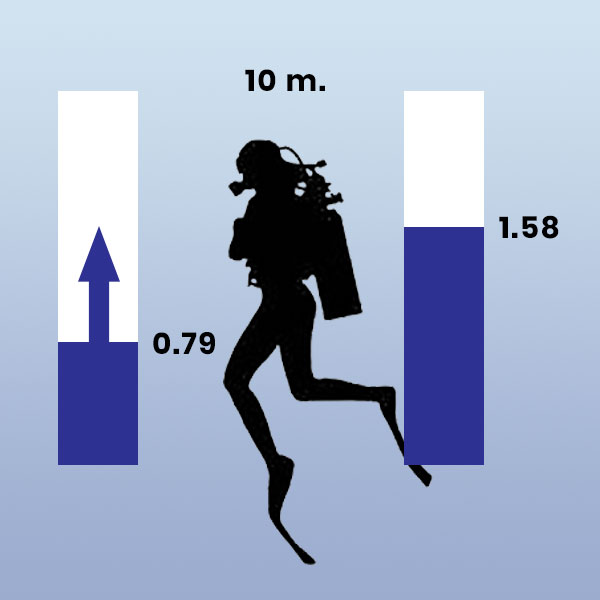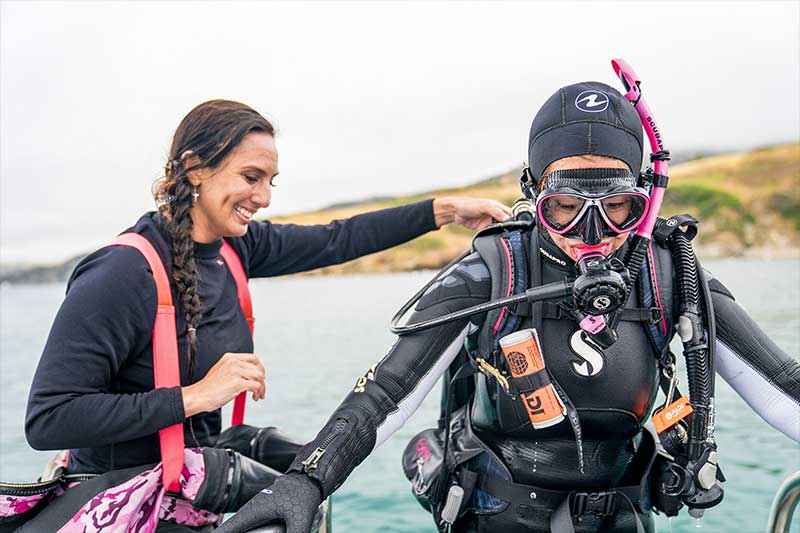PADI Dive Theory
PADI dive theory – Decompression theory and the RDP is one of 5 subjects that will be tested on the PADI Instructor exam.
I have made these materials to help you to prepare for your PADI Instructor exam or PADI Divemaster exam. If you choose to do your PADI Divemaster course or PADI IDC with Asia Scuba Instructors you will have access to many more materials in our ‘online classroom’.
The PADI Dive theory Studyguide and practice exams are also available in German language.
Decompression theory and the RDP
The Haldanean Decompression Model
Almost all dive tables and dive computers are based on a Haldanean decompression model. This is named after John Scott Haldane who developed the first mathematical formula (model) for decompression sickness.
Modern decompression models are based on the same ideas.
Tissue pressure
When a diver is on the surface, he is breathing air at a pressure of 1 Bar. Air has 21% oxygen and 79% nitrogen. The nitrogen exerts a partial pressure of 0.79 Bar.
The human body absorbs nitrogen. As you have learned in physics, dissolved gasses can also exert pressure. The pressure of nitrogen in the diver’s body, when he is breathing air on the surface, is also 0.79 Bar. The nitrogen pressure in the diver’s body (tissue pressure) is in balance with the nitrogen pressure in the air that he is breathing.

Pressure gradient
When the diver descends to a given depth, the nitrogen pressure in his breathing air is higher than the nitrogen tissue pressure in his body, so more nitrogen dissolves into the body tissues.
The difference between the dissolved nitrogen tissue pressure and the nitrogen pressure in the breathing air is called the pressure gradient. Tissue pressure and pressure gradient are normally expressed as partial pressure nitrogen, PPN2 (Bar).
With enough time, the nitrogen tissue pressure again will be the same as the nitrogen pressure in his breathing air. No more nitrogen will be dissolved in his body, as long as the diver stays on the same depth. This is called saturation.


Supersaturation
When the diver ascends, the nitrogen tissue pressure in the body becomes higher than the nitrogen pressure in his breathing air, causing the tissues to release nitrogen. This is called supersaturation. The tissues will release nitrogen until again, a balance is reached.
After every dive, the diver will be supersaturated. This does not necessarily cause decompression sickness. However, if the pressure gradient exceeds acceptable limits bubbles may form and cause decompression sickness.
These limits are dictated by the decompression model from the RDP table or computer and are called the M-values.

Halftime
How quickly or slowly the pressure gradient changes is defined by the halftime. Halftime can be explained as the time it takes to reduce a certain value to half (in this case the pressure gradient). Halftime is used to calculate nitrogen release as well as nitrogen absorption.
If the halftime is 1 hour, the pressure gradient will be reduced to 50% after 1 hour, 25% after 2 hours, 12.5% after 3 hours and so on. After 6 halftimes (1.56%) the pressure gradient is considered zero (saturated).

Tissue compartments
Haldane discovered that different parts of the body have different halftimes. They absorb and release dissolved nitrogen at different rates.
To account for these differences he constructed a mathematical model consisting of five theoretical tissues. These are called tissue compartments.
These theoretical tissue compartments do not directly correspond to any particular body tissue. They are only used to simplify calculations.
Each compartment has a different halftime for the rate at which it absorbs and releases nitrogen (slow and fast compartments).
Besides different halftimes, each compartment has a different M-value.
The slower compartments have lower M-values.
The faster compartments have higher M-values.
The M-values have been determined by performing Doppler tests on divers after actual test dives.
Controlling compartment
If a diver becomes saturated on a shallow dive, the pressure gradient may still be lower than the M-value in the faster compartments. However, if the diver stays shallow for an extremely long time or if he makes several shallow dives in a short period, eventually the pressure gradient in the slower tissue compartments may become higher than the M-value.
The compartment that reaches its M-value first is called the controlling compartment.
On shallow dives, the controlling compartment is a slow compartment. On deep dives, the controlling compartment will be a fast compartment.
Example:
A diver makes a dive to 10 meters depth. The partial pressure of nitrogen in his breathing air is:
2 * 0.79 Bar = 1.58 Bar
The fast tissue compartments in her body have a halftime of 5 minutes. After 6 * 5 minutes = 30 minutes, they will be saturated and reach a partial pressure of 1.58 bar. This is lower than the M-value of this compartment. Because the tissue compartment is saturated it’s partial pressure will never become higher than 1.58. Even if the diver stays at the same depth for a very long time.
One of the slower tissue compartments has a halftime of 37 minutes. After 6 * 37 minutes = 222 minutes, this compartment will also be saturated and reach 1.58 Bar partial pressure. This may be higher than the M-value for this compartment, meaning the diver has an unacceptably high risk to develop DCS.
This is a very long dive (more than 3,5 hours) but you should remember that slow tissue compartments also release nitrogen slower during the surface interval. After a short surface interval, the slower compartments may not have released all nitrogen. When making several shallow dives in a short period, the controlling compartment will also be a slow compartment.
When any compartment reaches its M-value the dive ends or it becomes a decompression dive. Remember that the M-values are calculated for surfacing at sea level which is why you need to apply special procedures when diving at altitudes above 300m.
Remember: All decompression models are theoretical representations of dives. There is no direct relationship between the decompression model and the human body. Some divers are more susceptible to DCS than others. There is always some risk of DCS. This is why we teach divers to avoid diving close to the limits of their tables or dive computer.

US Navy tables
The first dive tables to be widely used and adapted to recreational diving where the US Navy tables designed in the 1950’s. Most recreational divers and dive instructors at that time had a military background and the Navy tables were accessible for everybody.
The US Navy table uses six compartments with a slowest halftime of 120 minutes.
For surface intervals, a 120 minutes halftime is used to calculate nitrogen release, so it takes 12 hours (720 mins. 6 x 120) to release all nitrogen.
The Recreational Dive Planner (RDP)
In the mid-1980’s, Dr. Raymond Rogers recognized that the USN tables were not ideal for recreational diving.
The US Navy divers were all male in their 20’s and 30’s and reasonably fit. They would normally make long dives that would include drills or exercises.
For recreational divers that consist of all genders and age groups and would make several relaxed dives in a day, the surface credit based on a 120-minute halftime seemed very conservative. For this reason, Dr. Rogers used a 60-minute compartment to calculate surface intervals. The WXYZ rules make sure the slower compartments stay within limits.
New technology (Doppler ultrasound) showed that silent bubbles often occurred when diving to the limits of the US Navy tables. Dr. Rogers suggested that lower M-values would be more appropriate for recreational divers.
With the help of DSAT (Diving Science & Technology), Rogers developed the RDP – Recreational Dive Planner.
The RDP uses 14 compartments, instead of the 6 used in the US Navy tables. To calculate the surface interval, the RDP uses a 60-minute halftime, instead of 120 minutes on the US Navy tables.
The pressure groups from the RDP are NOT interchangeable with the US Navy table or with dive tables from other agencies.
eRDPml
When planning dives with the RDP it is assumed that the diver stays a the planned depth during the entire dive. The main advantage of the eRDPml (electronic RDP for multi-level) is that divers can plan multi-level dives. The pressure groups on the eRDPml are the same as on the RDP. However, since depths and times on the RDP table are often rounded, calculations can have different results (there is no 19 meter on the RDP).
The eRDPml is not a dive computer and can not be taken underwater.

Dive Computers
Nowadays dive computers are the most accurate way to plan a dive. Most dive computers calculate no-decompression time using a 1-minute interval – this eliminates unnecessary rounding. In some models, the calculation interval can be changed.
Dive computers can use different algorithms that are known under different names like Spencer Limits, Buhlmann, RGBM (Reduced Gradient Bubble Model). These models are essentially still based on Haldane’s original mathematical model.
While dive tables use a fixed halftime to calculate the surface interval, most dive computers assume that all compartments release nitrogen at the surface at their underwater halftime rates. This is called EE washout (exponential absorption – exponential release).

PADI Recommendation for Diving with Computers
• Divers should not share a dive computer.
• Each diver must have his own computer and use the same computer through a series of dives.
• Computers have the same theoretical basis as tables so one is neither better nor safer than the other.
• All standard guidelines apply, such as deepest dives first.
• Follow all manufacturers’ recommendations.
• End the dive based on the most conservative computer of a buddy team.
• If a computer fails during a dive, ascend slowly to 5m and make a long safety stop as long as your air supply permits. Remain out of the water for 12 – 24 hours, so you can start clear again with another table or computer.